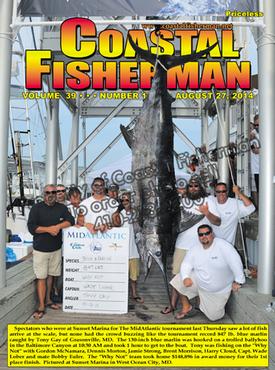


Article by Capt. Steve Katz
 Can you see in the dark?
Can you see in the dark?
Boating in the dark is often a necessity, usually on the way to or from a fishing spot, during an unexpected delay or on an extended voyage.
Using your GPS chartplotter and/or radar is a great way to know where you are and what is around you. Radar does a great job of displaying large objects like boats and land that reflect a radar signal well. A GPS chartplotter can show you where your boat is in relation to an electronic chart, helping you navigate to your destination.
Once darkness falls, the ability to see through the dark is comforting and adds a layer of safety. There are two popular technologies used to help us see in the dark, night vision and thermal imaging.
The first is the traditional “night vision”. This is the fuzzy green pictures you may have seen from military or police videos. This technology was first used in World War II and consists of a camera sensor that intensifies the existing light (however little exists) or supplies it’s own near infrared light to render the greenish image of what is in front of the lens. The green image was chosen by manufacturers because our eyes are most sensitive to green light and it shows the most accurate, user friendly picture for humans to see. This technology can sometimes offer more detail because it responds to light more like the eye does.
These systems have come down in cost and may be a great addition to your onboard gear. Since this night vision requires reflected light, they do not work well at long range, or when it is very dark, rainy or foggy. It is a good tool to read numbers on a buoy, see a wake in the water or other features in detail, similar to how you would see in the daytime. These devices come in many physical forms, with the hand held binocular or monocular styles being the most popular and affordable, beginning at around $400 for a first generation marine night vision monocular.
The second popular type of “night vision” is thermal imaging or a thermal camera (often called FLIR, an acronym for Forward Looking Infra Red). Thermal night-vision cameras rely on technology that senses minute temperature differences — not reflected light. Consumer FLIR cameras use a lens to capture temperature information and focus it onto a Vanadium Oxide microbolometer. This device converts the temperature measurement into electrical signals that are processed to produce the image we see. The system works the same way during the daytime as it does at night, since ambient light is not used. The FLIR device can help you spot objects that may be hard to see, even during daylight hours.
FLIR devices were original developed for and used in the military, police and firefighting markets due to their high costs. Now, some of these FLIR devices have become more affordable for boating use, with consumer marine devices starting at $2,000.
Accident avoidance is a an area where a thermal camera can help you see objects floating in the water. The objects will usually have a different temperature that the surrounding water and therefore be differentiated on the screen. Other objects such as boats, land masses, buoys and people are easily identified.
If you are using this system for search and rescue, like looking for a 98-degree person in 75-degree water, the FLIR?device will make the person easy to spot due to the contrast of temperature resulting in a color difference in the displayed image. No other technology finds people in the water faster.
The type and screen resolution used to display the thermal image from a mounted camera can make a significant difference in picture quality, so be sure you are using the recommended screen size and resolution for the FLIR hardware you are using. These cameras usually work in light rain or light fog, but heavier precipitation can appear as a wall of same temperature objects in front of the camera, decreasing the usefulness of the camera during the bad weather. These systems are very good for long distance viewing but are not often helpful in reading number on a buoy. This is because the camera zeros in on the temperature of the object, so if the buoy numbers are the same temperature as the buoy, the system does not differentiate between the two and the buoy appears without numbers.
The most popular marine thermal cameras are made by FLIR Systems Inc, the largest commercial thermal imaging company in the world. For the marine market, their models begin with the small handheld monocular systems and the small mounted cameras, both stationary or pan/tilt. The hand-held type cameras begin at around $2,000 and a fixed mount MD series begin around $3,500.
A nice feature of the FLIR M Series is the integration with today’s modern chart plotters. In addition to seeing the FLIR picture on the screen, many chartplotter displays allow you to use the touchscreen to control camera movements and settings. An interesting feature on some of these chartplotters is the “Slew-to-Cue” feature that allows the chartplotter to keep the camera pointed to and track a specific object, such as a boat moving towards you at the same time your vessel is on the move. This tight integration with FLIR is available with chartplotters from Furuno, Simrad, Garmin and Raymarine.
Both of these technologies are a good tool for nighttime navigation, shipboard security, man overboard situations, anti-piracy and many other applications. It’s ideal for seeing channel markers, shipping lane traffic, outcroppings of land, bridge pilings, debris, exposed rocks, other vessels and indeed any other hazardous floating object.
Captain Steve Katz is the owner of Steve's Marine Service and holds NMEA MEI, AMEI, NMEA2000 certificates, ABYC Master Technician certification and factory training from many manufacturers.